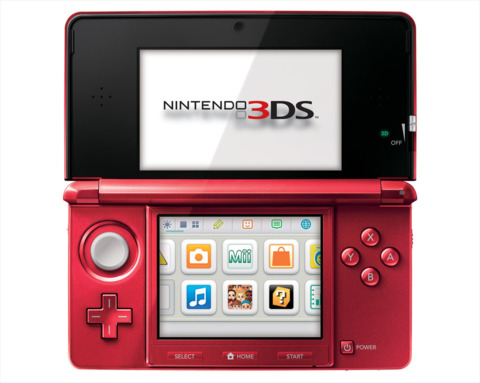Nintendo trading in the blue ocean for a white flag?
Reports of a 3DS analog add-on suggest the once-confident company is neck-deep in knee-jerk reactions.
As you may have heard by now, the latest issue of Famitsu unveils a new Nintendo 3DS peripheral, a shell that effectively gives the handheld a second analog pad along its right edge. If you track down scans of the magazine (we won't host them as a courtesy to Famitsu and its original content), you can see it's not pretty.
Of course, "It's not pretty" describes the current state of Nintendo just as well as it does the new peripheral. For years, the company has blithely done things The Nintendo Way, ignoring current trends and bucking conventional wisdom to produce both breakthrough hits like the Game Boy and ignoble failures like the Virtual Boy. As a result, when Nintendo's unconventional ways pay off, they pay off in a big way by cornering a market that maybe didn't exist previously.
It's the "blue ocean" strategy. By sailing into uncharted waters, Nintendo knows there won't be any competition waiting for it. Just look at the DS and the Wii for recent examples, or go back to the launch of the NES in the wake of the game industry crash. And even when Nintendo is completely, infuriatingly, stubbornly wrong--as it has been for a decade now with its halfhearted approach to online gaming--it's at least failing in its own inimitable way.

And this is what makes the revelation of an analog pad cradle for the 3DS so concerning, because the second analog stick is such an obvious improvement. It's like using a disc-based storage medium, letting third parties put blood in their games, or having a back light standard on portable hardware. Nintendo caved on all three issues, but it took its sweet time in caving. Not so with the 3DS.
Six months ago, Nintendo was rock solid on the system. It reasoned that a single analog pad was plenty, especially since the DS didn't even have that going for it. Even with a substandard launch lineup, the system would naturally fly off the shelves, much as the original DS had done in its first months on sale. Third-party publishers would then feel a need to create games for the hardware, giving people more reason to own the system, and Nintendo would have another DS-scale hit on its hands. Misguided though it might have been, that is emblematic of the confidence Nintendo has always had in its products and its processes.
The best examples of that confidence (and the benefits thereof) can be seen in Nintendo's not-too-distant past. The DS, Wii, and Wii Fit represented perhaps the greatest single stretch of game industry innovations to date. The initial reactions to all three ranged from "interesting" to "insane," but the financial fortunes of each were outright incredible.
The DS and the Wii have been Nintendo's best-selling hardware ever. Through June of this year, the DS family has sold 147.8 million systems, topping even the Game Boy's 118.7 million sold. Meanwhile, the Wii boasts an installed base of 87.6 million and counting, well ahead of the 61.9 million sold by Nintendo's next-best-selling console, the original NES.
Wii Fit sold nearly 22.7 million copies through March of 2011--not too shabby for a $90 game packed in with a glorified bathroom scale. Wii Fit Plus notched another 18.5 million sold. Together, they topped the unit sales of New Super Mario Bros. Wii, Super Mario Galaxy, and Super Mario Galaxy 2 combined, with several million to spare. (Historical sales pulled from Nintendo's 2010 and 2011 annual reports; lifetime-to-date DS and Wii sales pulled from the company's latest quarterly report.)
In each of those cases, Nintendo went out on a limb because it identified an underserved market and an appetite for nontraditional content. Fast-forward to today, and Nintendo behaves like a very different company, one more prone to knee-jerk reactions than confident contrarianism. The 3DS launched with a whimper, and the company reacted by drastically slashing the price, even more drastically cutting the paycheck of its top executive, and pledging to give early adopters a small library of emulated classics as an apology for gouging them at launch.
Despite the price cut, third-party support for the 3DS was a continuing concern. Ubisoft canceled its 3DS installment of Assassin's Creed. THQ canceled its Saints Row spin-off, one of the legs of its highly touted trans-media play to cross-promote games like Saints Row the Third. The system had a single North American retail game released for it in July (Pac-Man & Galaga Dimensions), the sort of postlaunch drought that one would have hoped was a thing of the past. Natsume reportedly delayed the release of two of its 3DS titles specifically to wait for the system's installed base to grow.
This second analog stick seems like a nod to third parties who would rather port versions of their console or Vita games to the 3DS than build new experiences from scratch, which was essentially a prerequisite for the DS editions of popular games. However, given that the 3DS installed base is already lacking in publishers' eyes, the inherently smaller installed base of the second analog pad attachment won't look much better. Consider that the bulky attachment ruins whatever aesthetic appeal the system has and will almost certainly make it incompatible with all but the most absurdly sized pockets, and that installed base will need a killer app to end all killer apps if it wants to make a dent in the system's financial fate.
At best, the 3DS controller attachment is a curiosity, a dead-end peripheral that is supported by one or two games and will be quickly forgotten by the market. Think of the GameCube modem, the Wii Speak, or, better yet, the never-actually-released Vitality Sensor, three more Nintendo hardware innovations that spent their brief lives in search of a reason to exist.
At worst, the right analog stick is a white flag for a company that has run out of ideas. It is an admission that Nintendo was wrong and shortsighted to ignore what has become an industry standard, wrong to pursue its own path with confidence. And if that's the case, Nintendo has lost the very quality that defines it, and the coming years could chronicle a fall from grace to surpass that of other onetime hardware titans, such as Atari and Sega.
Got a news tip or want to contact us directly? Email news@gamespot.com

Join the conversation